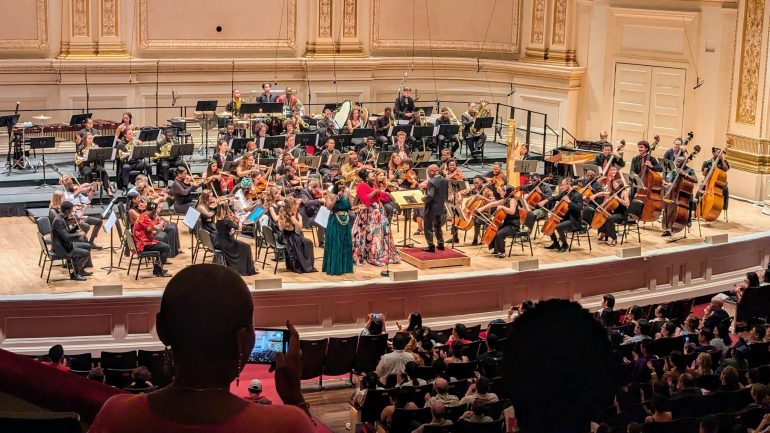
By Seth Onyango, via bird story agency
The anticipation at Carnegie Hall was palpable. As the Africa United Youth Orchestra took to the stage, the venue buzzed with the promise of a historic performance that would echo far beyond the venerable walls of this iconic venue.
A diverse audience, representing a tapestry of cultures, settled into their seats, their murmurs hushed by the dimming lights.
The stage transformed into a vibrant mosaic of young musicians, each from a different corner of Africa, with instruments gleaming under the stage lights.
Strings, woodwinds, brass, and percussion sections formed a harmonious ensemble, their sheer number a testament to the evening’s epic scale.
The concert began with a tribute to South African musical heritage. Michael Moerane’s Fatse Laheso, the first symphonic work composed by a black South African in 1941, filled the hall.
The piece, meaning “My Country,” resonated deeply, its powerful notes weaving a narrative of pride and resilience. As the final chords lingered, the audience erupted into applause, setting a powerful tone for the evening.
Next, the orchestra delved into the evocative strains of Mziliga Zikumalo’s uShaka KaSenzangakhona and Princess Magogo kaDinuzulu, the first Zulu opera. The music ebbed and flowed, capturing the rich blend of African operatic tradition.
The musicians, some barely in their teens, played with a maturity and passion that belied their years, drawing the audience into a world of myth and majesty.
The highlight of the evening was Bongani Ndodana-Breen’s three-song cycle, based on the Yonka poems famously read by Nelson Mandela in Parliament, his first in the August House.
When the first notes of Afrikaans ever sung at Carnegie Hall reverberated through the space, the audience sat spellbound. The historical significance of this moment was not lost on anyone, especially the young performers.
Mark Weiz from Nairobi Music Society posits that the performance was a powerful cultural statement that signals a shift in global cultural dynamics, where African voices are becoming central to the narrative.
“The ability of these young musicians to perform such complex works at a venue like Carnegie Hall signals a new era of recognition and respect for African contributions to classical music,” he said.
“It opens up new possibilities for African musicians in the global arena.
At just 20 years, Gilah Kellner of Stellenbosch University’s Music Department is AUYO’s Concertmaster, the highest leadership position after the conductor.
“I think every violinist who has dreams of becoming a real, professional musician, dreams of playing in Carnegie Hall. But I didn’t quite realize the weight of this until I stepped into the hall, and the conductor was telling us, like, this is where legends have stood. People that you know are absolute stars,” she told reporters.
“This is also the first time a whole African orchestra has played on this stage. It was such an… it’s the greatest one.”
Twenty-two-year-old Blandina Dimanda from Maputo, Mozambique, only started playing the violin in 2016 but described this trip as a huge moment to represent her country on the global stage.
For 30-year-old Olawale Olayinka, a Nigerian violinist from Nigeria’s Osun state who has played the instrument since 2010, performing at Carnegie Hall was exhilarating.
“When I got the message about the…When I got the message about the auditions to get into the AUYO, I said, yes, I have to be a part of this. Because I don’t know if I just would not let this opportunity, because it’s golden. I cannot let this pass,” he shared.
Meanwhile, a thunderous ovation followed, a standing tribute to the young musicians who had so masterfully bridged continents and cultures with their performance.
The conductor, his face beaming with pride, acknowledged the audience’s appreciation with a gracious bow, his baton held aloft in triumph.
After their triumph at Carnegie Hall, the African musicians joined an international ensemble of youth orchestras from China, the European Union, Afghanistan, Venezuela, and the United States.
This grand assembly of over 700 musicians was conducted by the illustrious Gustavo Dudamel, Music Director of the Los Angeles Philharmonic and the future Music and Artistic Director of the New York Philharmonic.
Under Dudamel’s leadership, the orchestra embarked on a symphonic journey that transcended borders and languages.
The grand finale of World Orchestra Week showcased the unifying power of music, demonstrating how a shared passion can bring together people from vastly different backgrounds in harmony and understanding.
“Pata Pata,” popularized internationally by the iconic Maria Makeba, was one of the standout pieces, performed with a verve that honoured its roots while bringing it into a grand orchestral context.
This piece, along with the others, exemplified the concert’s mission: to present music that reflects South Africa’s rich cultural heritage and, in future performances, to include works by composers from other parts of Africa.
bird story agency











